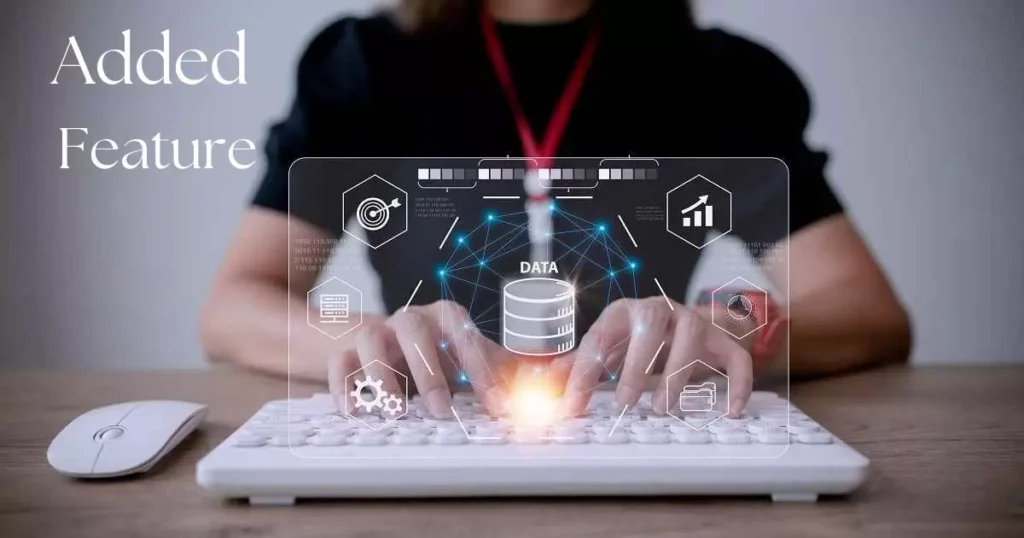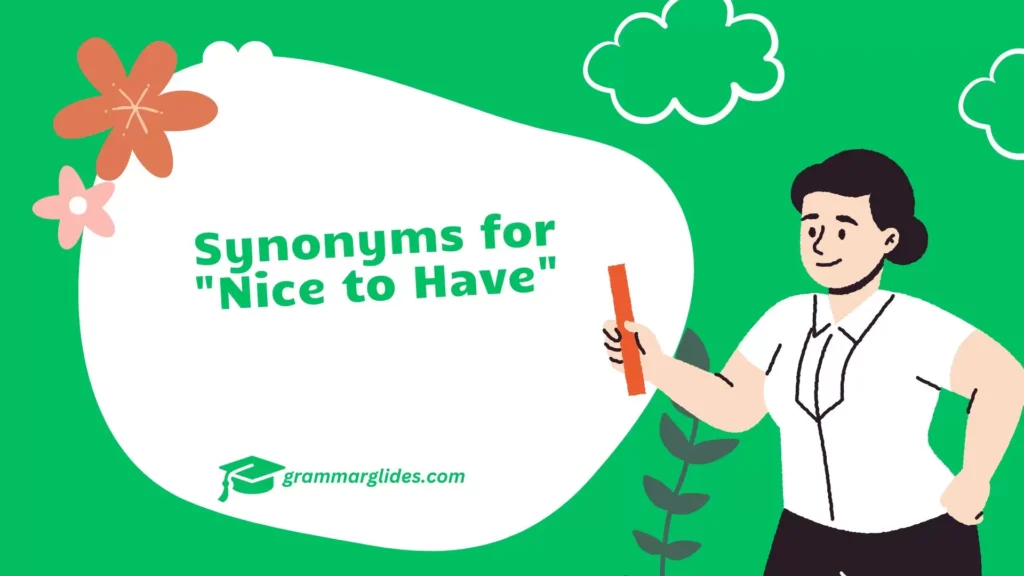In both professional and casual settings, expressing the value of additional features or benefits can enhance communication. The phrase “nice to have” is commonly used to describe something that adds value but isn’t essential.
However, there are various other expressions you can use to convey a similar sentiment. This blog post explores different ways to articulate the concept of something being advantageous but not necessary.
1. Desirable
Scenario: Describing a feature in a product that enhances its appeal.
Examples:
- “The new touchscreen is a desirable feature in this model.”
- “Having a built-in GPS is a desirable addition to the car.”
Explanation: “Desirable” emphasizes the attractiveness of a feature without implying it’s a necessity.
2. Beneficial
Scenario: Highlighting an added feature that provides extra value.
Examples:
- “The extended warranty is beneficial for peace of mind.”
- “A dedicated workspace in the office is beneficial for productivity.”
Explanation: “Beneficial” indicates that something offers a positive advantage but isn’t critical.
3. Advantageous

Scenario: Referring to a feature that improves usability or convenience.
Examples:
- “Having a backup power source is advantageous during outages.”
- “The extra storage space is advantageous for organizing files.”
Explanation: “Advantageous” highlights the added value or benefit provided by a feature.
4. Valuable
Scenario: Describing an optional feature that enhances overall worth.
Examples:
- “The membership perks are valuable even though they’re not essential.”
- “A higher resolution camera is valuable for detailed photography.”
Explanation: “Valuable” underscores the importance and worth of an additional feature.
5. Helpful
Scenario: Noting a feature that improves functionality or convenience.
Examples:
- “A user-friendly interface is helpful for new users.”
- “The additional software tools are helpful for streamlining tasks.”
Explanation: “Helpful” conveys that something aids or supports but isn’t indispensable.
6. Nice-to-Have
Scenario: Using the original term to describe an optional benefit.
Examples:
- “A coffee machine in the office is a nice-to-have for morning meetings.”
- “A larger display is a nice-to-have for presentations.”
Explanation: “Nice-to-have” is a direct expression of something that adds comfort or convenience but is not crucial.
7. Optional
Scenario: Describing a feature that can be added but is not required.
Examples:
- “The extra features are optional and can be added based on preference.”
- “A deluxe version with more amenities is optional for customers.”
Explanation: “Optional” indicates that the feature is available but not necessary.
8. Add-on
Scenario: Referring to a supplementary feature that enhances the main product.
Examples:
- “The premium support package is an add-on that improves service.”
- “An extra battery is an add-on that extends usage time.”
Explanation: “Add-on” suggests something that complements the main offering without being essential.
9. Supplementary
Scenario: Highlighting an extra feature that supports the main function.
Examples:
- “The supplementary resources are useful for deeper learning.”
- “A supplementary tool enhances the functionality of the software.”
Explanation: “Supplementary” denotes something that supports or adds to the core elements.
Other Ways to Say “Having Said That”
10. Optional Extra
Scenario: Referring to an additional feature that is not necessary but adds value.
Examples:
- “The optional extra of a heated seat is available in the luxury model.”
- “An optional extra of a larger screen can be selected for the device.”
Explanation: “Optional extra” describes something that can be added for additional benefit.
11. Perk
Scenario: Describing an additional benefit or feature that enhances value.
Examples:
- “The membership includes several perks, such as free parking.”
- “One of the perks of the new plan is a higher data limit.”
Explanation: “Perk” conveys an added benefit that enhances overall appeal.
12. Enhancement
Scenario: Highlighting a feature that improves the existing offer.
Examples:
- “The software update includes several enhancements for better performance.”
- “An enhancement to the user interface makes the system more intuitive.”
Explanation: “Enhancement” signifies an improvement that adds value but is not essential.
13. Luxurious Addition
Scenario: Referring to a high-end feature that adds comfort.
Examples:
- “A heated pool is a luxurious addition to the resort’s amenities.”
- “The plush leather seats are a luxurious addition to the vehicle.”
Explanation: “Luxurious addition” emphasizes the high-end nature of the feature, which adds comfort and style.
14. Bonus Feature
Scenario: Describing an extra feature that provides added benefit.
Examples:
- “The new app version includes a bonus feature for improved customization.”
- “A bonus feature of the package is a free subscription to a premium service.”
Explanation: “Bonus feature” highlights an extra benefit that enhances the main offering.
15. Extra Benefit
Scenario: Noting an additional advantage that is not essential.
Examples:
- “The seminar offers an extra benefit of networking opportunities.”
- “An extra benefit of the plan is access to exclusive content.”
Explanation: “Extra benefit” indicates something additional that provides added value.
16. Complementary Feature
Scenario: Referring to a feature that complements the main product.
Examples:
- “The complementary feature of an adjustable stand enhances usability.”
- “A complementary app provides additional functionality to the device.”
Explanation: “Complementary feature” signifies an added element that supports the primary function.
17. Additional Asset
Scenario: Describing an extra feature that adds to the overall value.
Examples:
- “The additional asset of advanced analytics tools improves decision-making.”
- “An additional asset of the property is its scenic location.”
Explanation: “Additional asset” denotes something that adds to the value or appeal but is not required.
18. Added Value
Scenario: Highlighting a feature that enhances the overall offering.
Examples:
- “The added value of a free upgrade makes the purchase more attractive.”
- “A warranty extension provides added value to the product.”
Explanation: “Added value” emphasizes the enhancement provided by the additional feature.
19. Optional Feature
Scenario: Referring to a feature that is available but not necessary.
Examples:
- “An optional feature such as a sunroof can be included in the package.”
- “The software includes several optional features for advanced users.”
Explanation: “Optional feature” indicates that the feature is available but not essential.
20. Enhancing Element
Scenario: Describing a feature that improves the main offering.
Examples:
- “The new design includes an enhancing element that adds to its functionality.”
- “An enhancing element like the noise-canceling feature improves user experience.”
Explanation: “Enhancing element” conveys that the feature improves the main product or service.
21. Convenient Addition
Scenario: Referring to a feature that adds convenience.
Examples:
- “The portable charger is a convenient addition for travelers.”
- “A built-in alarm system is a convenient addition for home security.”
Explanation: “Convenient addition” highlights the ease and practicality of the extra feature.
22. Optional Upgrade
Scenario: Describing an additional upgrade that can be chosen.
Examples:
- “An optional upgrade to the premium package provides additional features.”
- “The service includes an optional upgrade for extended support.”
Explanation: “Optional upgrade” denotes an additional enhancement that is available but not necessary.
23. Nice Touch
Scenario: Referring to an additional feature that adds to the overall experience.
Examples:
- “The complimentary gift is a nice touch to the purchase.”
- “The extra detail in the packaging is a nice touch.”
Explanation: “Nice touch” indicates a pleasant addition that enhances the overall experience.
24. Perquisite
Scenario: Describing a feature that is an additional benefit.
Examples:
- “The membership comes with several perquisites, such as free workshops.”
- “An perquisite of the new role is access to exclusive training programs.”
Explanation: “Perquisite” is a formal term for an additional benefit or feature.
25. Supplemental Feature
Scenario: Referring to an additional feature that supports the main product.
Examples:
- “The supplemental feature of voice control adds to the product’s functionality.”
- “A supplemental feature such as a carrying case enhances usability.”
Explanation: “Supplemental feature” suggests an additional element that supports or complements the primary function.
26. Desirable Quality
Scenario: Highlighting a feature that adds to the appeal.
Examples:
- “The eco-friendly design is a desirable quality for environmentally-conscious consumers.”
- “A desirable quality of the new model is its sleek design.”
Explanation: “Desirable quality” emphasizes the appealing nature of an additional feature.
27. Optional Accessory
Scenario: Describing an accessory that can be added but isn’t necessary.
Examples:
- “The leather case is an optional accessory for the gadget.”
- “An optional accessory like a stylus pen adds functionality.”
Explanation: “Optional accessory” indicates an additional item that enhances the main product.
28. Added Feature

Scenario: Referring to an extra feature that improves the main offering.
Examples:
- “The added feature of Bluetooth connectivity enhances the device’s versatility.”
- “An added feature like a built-in projector makes the product more useful.”
Explanation: “Added feature” denotes something that improves or extends the functionality of the main product.
29. Nice-to-Have Item
Scenario: Describing a feature that adds value but is not essential.
Examples:
- “The smart thermostat is a nice-to-have item for home automation.”
- “A nice-to-have item like a built-in coffee maker adds comfort.”
Explanation: “Nice-to-have item” is a way of saying that something is beneficial but not crucial.
30. Optional Benefit
Scenario: Highlighting an additional benefit that is not required.
Examples:
- “The optional benefit of priority support can be added to your subscription.”
- “An optional benefit of the membership is early access to events.”
Explanation: “Optional benefit” indicates an additional advantage that enhances the primary offering.
Conclusion
Exploring various synonyms for “nice to have” allows for more precise and engaging communication. Whether you’re discussing additional features, optional benefits, or desirable qualities, these alternatives help convey the added value of non-essential elements.
Use these expressions to enhance your descriptions and better communicate the benefits of ext features in both professional and casual contexts.

Hi! I’m Lauren Reynolds, the author of Grammar Glides. I create easy-to-follow content that helps you master English with confidence. Let’s make learning English simple and enjoyable together!

